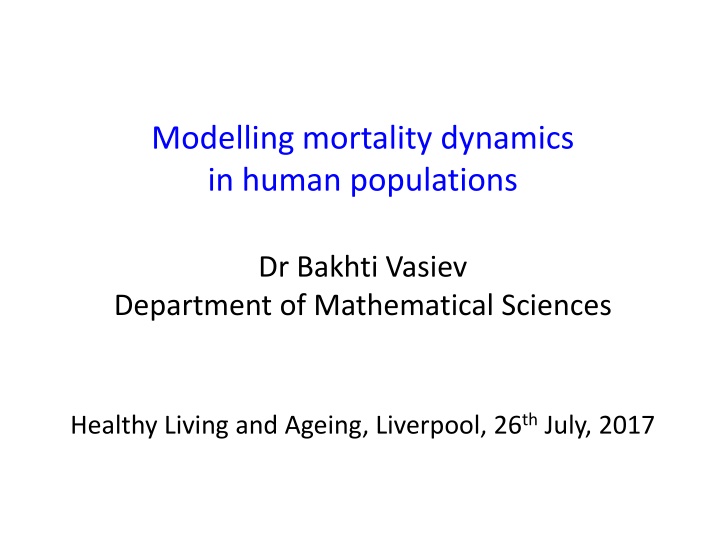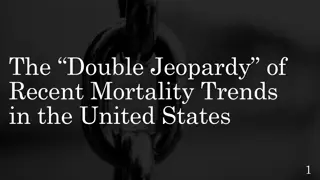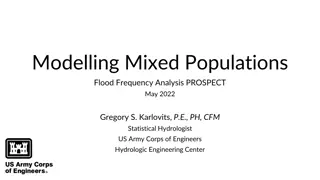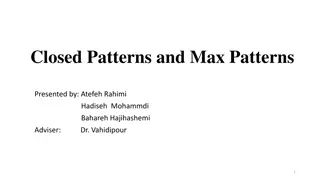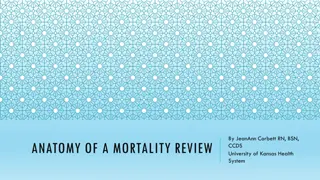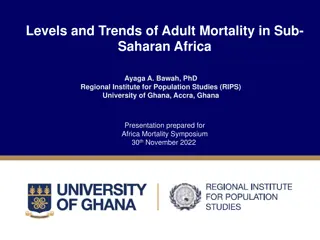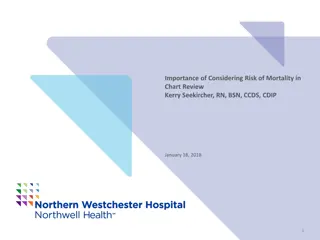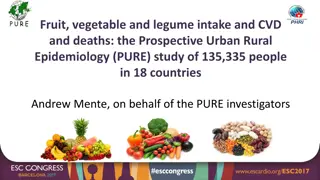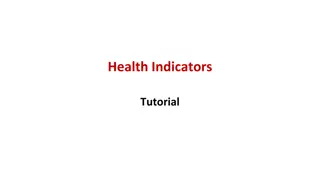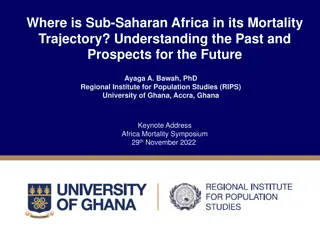Mortality Dynamics in Human Populations: Modeling Trends and Patterns
Explore the dynamics of mortality in human populations through concepts like Gompertz Law, Compensation Effect, and Late-life Deceleration. Discover how mathematical models help analyze mortality data, predict future trends, and guide research for healthier aging.
Download Presentation

Please find below an Image/Link to download the presentation.
The content on the website is provided AS IS for your information and personal use only. It may not be sold, licensed, or shared on other websites without obtaining consent from the author.If you encounter any issues during the download, it is possible that the publisher has removed the file from their server.
You are allowed to download the files provided on this website for personal or commercial use, subject to the condition that they are used lawfully. All files are the property of their respective owners.
The content on the website is provided AS IS for your information and personal use only. It may not be sold, licensed, or shared on other websites without obtaining consent from the author.
E N D
Presentation Transcript
Modelling mortality dynamics in human populations Dr Bakhti Vasiev Department of Mathematical Sciences Healthy Living and Ageing, Liverpool, 26th July, 2017
Overview Introduction: definitions and mortality laws Gompertz law Compensation effect Late-life deceleration Model of heterogeneous populations Description of the model Fitting to actual data Modelling evolution of mortality Evolution of subpopulations Homogenisation of population Future research
Definition of Mortality Definition of mortality for a population of size N: ? ? ? ? = where N is the number of deaths during the time interval t. The above definition of mortality can be seen as a probability to die for a random individual in the population within a unit time interval. Often mortality is defined for age groups, i.e. mortality at age x: ??= ?? ?? where ?? - number of deaths at age x and ?? - is the total number of individuals at age x (in this setting t=1).
Gompertz Law of Mortality Analysis of mortality data (for human and non-human populations) indicates (Gompertz, 1825) that in a wide range of ages the mortality increases exponentially with age: ??= ?0??? ?0is called the initial mortality and ? - the mortality coefficient. Deviations from this exponent are observed at young and old ages.
Actual mortality data 10 10 1 1 0.1 0.1 0.01 0.01 0.001 0.001 0.0001 0.0001 0.00001 0.00001 0 20 40 60 80 100 0 20 40 60 80 100 Data for 1990 Data for 2000 m0=8.86*10-5, =0.09 m0=1.76*10-5, =0.10 Swedish period data from Human Mortality Database: http://www.mortality.org
Compensation Law of mortality or Late-Life mortality convergence Comparing the mortality dynamics in different populations of the same species indicates (Strehler and Mildvan, 1960) that: High initial mortality is compensated with low rate of aging. Low initial mortality is compensated with high rate of aging. The Strehler and Mildvan correlation is expressed by: ln(?0) = ln ? ?? where ? is the species-specific lifespan and ? the species-specific mortality From Gavrilov and Gavrilova (2006)
Late-life mortality deceleration Observations at extreme old ages: 1) Deceleration 2) Level-off (plateau) 3) Decline 4) Fluctuations From Avraam et al. (2013) From Vaupel et al. (1998)
Model of heterogeneous populations Two main questions concerning Gompertz law of mortality: 1. Why the mortality increase is exponential? 2. Why it deviates from the expon nt at y ung and old ages? To address the second question we have developed a model of heterogeneous human population. We assume that the human population consists of a set of subpopulations which differ genetically or by life-style conditions. The mortality dynamics of each subpopulation (indexed j) follows the Gompertz law: ???= ??0? ???
Fitting heterogeneous model to actual data Gompertz parameters for each subpopulation are different. The mortality of the entire population is modelled as a sum of weighted exponential (Gompertz) terms: ? ??????= ?1??10??1?+ + ?????0???? ??= ?=1 Number of subpopulations and the values of parameters describing each of them are obtained by fitting the model (using statistical, i.e. BIC, criteria) to actual data.
Best fit is given by four-subpopulation model Heterogeneous model is fitted to the Swedish period mortality data for the year 1900 (panel A) and the year 2000 (panel B).
Evolution of mortality in terms of 4- subpopulation model
Evolution of mortality over 20th century in Sweden Time-evolution of mortality dynamics in the mathematical model of heterogeneous population
Reduction of Swedish mortality within one century Decline of mortality due to: 1) changes in the structure of the population (homogenization) 2) changes in the Gompertzian dynamics of the subpopulations
Homogenisation as a consequence of natural selection The relative fitnesses for two subpopulations are calculated for each year over the 20th century and shown in panel (A). The average ratio (0.27) of two fitnesses is used to calculate the changes in genotype frequencies due to natural (mortality) selection as shown in panel (B) over four generations (each lasting 25 calendar years).
Future work I: Mechanistic model for mortality dynamics Let s denote by ? the state of illness and by ? the state of healthiness. Therefore, ?? ??= ?? ?? + ?? ?? ??= ?? ?? where ? is the rate to get more ill ,? is the rate torecover and ? is the rate to getill . In this model the mortality (value of y) is given as superposition of exponents like in the heterogeneous model
Future work II: Evolution of mortality in virtual population A virtual population model: We consider a number of entities representing living organisms. Each organism is characterised by its age and genotype, particularly, we consider the population of diploids with subpopulations determined by genetic differences. Every time step the organisms in the modelled population get older and, with some probability (depending on their genotype), die. All organisms, reaching the reproductive period, mate and leave an offspring with some probability. The offspring carries a specific genotype related to its parents genotypes. Run simulations for a number of successive generations and analyse the evolution of mortality dynamics in the population.
People contributed to this research Dr Demetris Avraam (past PhD student) Dr Joao Pedro Magalhaes, Institute of Ageing and Chronic Disease, Liverpool University Dr Severine Gaille, the University of Lausanne (Switzerland) Dr Olga Vasieva (Ingenet, Liverpool) Mr Dyfan Jones (project student) Was never funded
